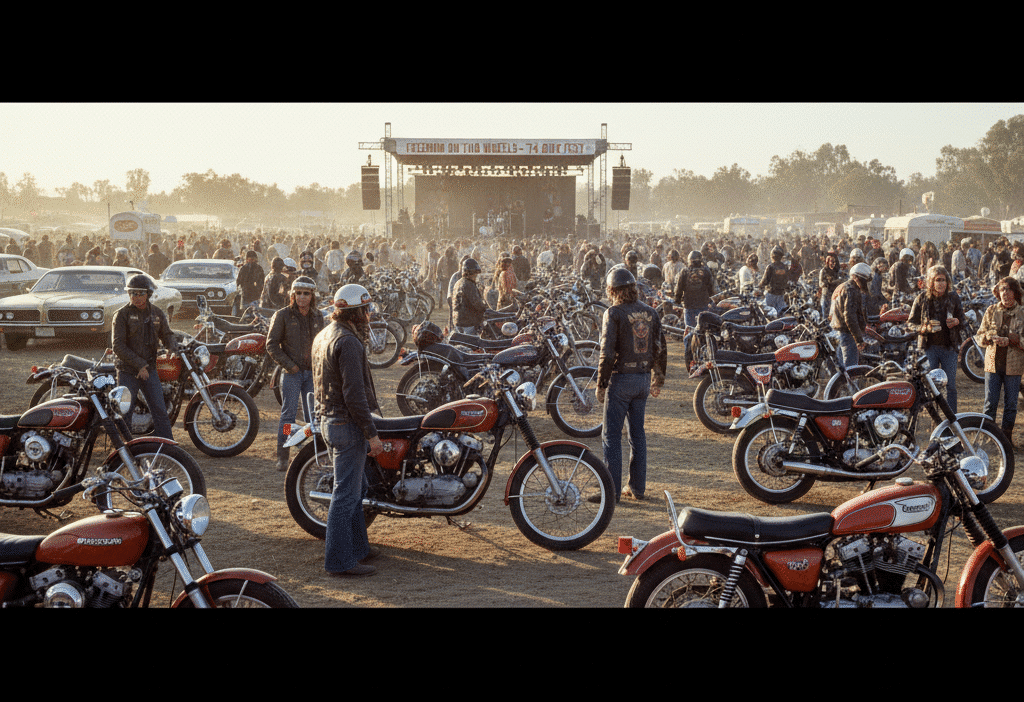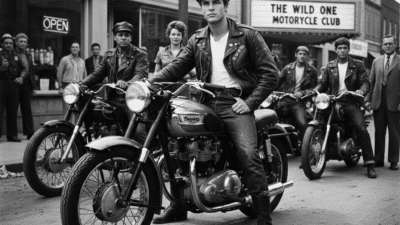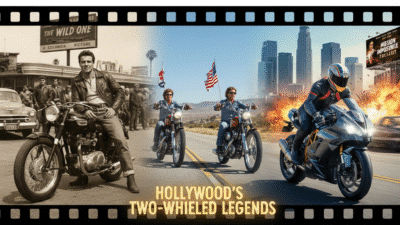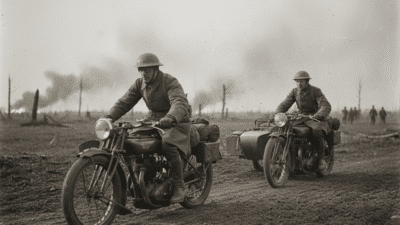Prepare to feel the rumble, hear the roar, and relive an era when the open road beckoned with irresistible force! The motorcycle boom of the 1970s wasn’t just a fleeting trend; it was a cultural phenomenon, a surge of two-wheeled freedom that reshaped transportation, influenced fashion, and ignited a passionate community that still thrives today. This wasn’t merely about getting from point A to B; it was about the journey itself, the wind in your hair, the raw power beneath you, and the undeniable sense of liberation that only a motorcycle could deliver. For an entire decade, motorcycles captured the imagination of millions, becoming symbols of rebellion, adventure, and personal expression. From the bustling city streets to the winding country roads, bikes were everywhere, ridden by everyone from college students to seasoned adventurers. Join us as we rev up our engines and dive deep into the exhilarating story of how the 70s became the golden age of motorcycling, and why its spirit continues to roar louder than ever!
Pros and Cons
| Pros | Cons |
|---|---|
| – Unprecedented freedom and personal expression | – Rising fuel costs (though less than cars) |
| – Affordable and accessible transportation | – Increased accident rates due to popularity |
| – Birth of iconic motorcycle designs and brands | – Environmental concerns began to emerge |
| – Fostered strong community and counter-culture movements | – Limited passenger capacity and cargo space |
| – Significant technological advancements in design | – Perceived as dangerous or rebellious by some |

The Perfect Storm: What Fueled the Boom?
The 1970s didn’t just stumble into a motorcycle boom; it was a decade ripe for its arrival, a convergence of economic, social, and cultural factors that created the ideal environment for two-wheeled machines to flourish. It was a time of shifting paradigms, where people yearned for independence and a break from the conventional.
Post-War Prosperity and Shifting Demographics
Following decades of post-World War II economic growth, a new generation had disposable income and a craving for excitement. The baby boomers were coming of age, seeking thrills, adventure, and ways to differentiate themselves from their parents. Motorcycles offered an accessible entry point into the world of personal motorized transport, far more affordable than cars for many young people. The market was expanding, ready to embrace new forms of mobility and leisure.
Youth Culture and the Spirit of Rebellion
The 60s had laid the groundwork for a counter-culture movement, and the 70s continued this narrative with a strong emphasis on individualism and nonconformity. Motorcycles, especially the stripped-down, custom bikes, became potent symbols of rebellion. Think “Easy Rider” and the pervasive image of the free-spirited biker challenging societal norms. This image resonated deeply with a youth eager to break free from tradition and embrace a more adventurous lifestyle. Owning a motorcycle was a statement, an emblem of personal freedom and a rejection of the mundane.
The Energy Crisis and Practicality
Paradoxically, the fuel crises of the 1970s, particularly the 1973 oil embargo, also played a significant role in boosting motorcycle sales. As gasoline prices skyrocketed and fuel rationing became a concern, smaller, more fuel-efficient vehicles gained immense appeal. Motorcycles, with their superior miles per gallon compared to the gas-guzzling cars of the era, suddenly became a pragmatic choice for commuting and daily transport. This wasn’t just about rebellious joyrides; it was about smart economics, making two wheels a sensible alternative to four.
Accessibility and Affordability
The sheer variety and competitive pricing of motorcycles from brands like Honda, Yamaha, Suzuki, and Kawasaki made them highly accessible. A wide range of models, from nimble 125cc commuters to powerful 750cc and 900cc superbikes, meant there was a bike for every budget and every riding style. This accessibility lowered the barrier to entry for countless new riders, transforming motorcycling from a niche pursuit into a mainstream passion.
Iconic Machines: The Bikes That Defined a Decade
The 1970s gave birth to some of the most legendary motorcycles in history, machines that weren’t just modes of transport but works of art, engineering marvels, and cultural icons. These bikes captivated riders with their power, styling, and reliability, forging legacies that endure to this day.
Japanese Dominance and the Superbike Era
The decade truly belonged to the Japanese manufacturers. Brands like Honda, Kawasaki, Suzuki, and Yamaha didn’t just enter the market; they redefined it, combining cutting-edge technology with mass production efficiency and aggressive marketing.
- Honda CB750: Though introduced in late ’69, the “King of the Road” truly reigned supreme in the 70s. Its inline-four engine, electric start, and disc brake were revolutionary, setting the standard for the modern superbike. It offered reliability and performance previously unheard of at its price point, making high-performance motorcycling accessible to the masses.
- Kawasaki Z1 (900 Super Four): Launched in 1972, the Z1 was Kawasaki’s answer to the CB750, and what an answer it was! With its larger 903cc engine, dual overhead camshafts, and blistering speed, it quickly earned a reputation as the fastest production motorcycle in the world. Its aggressive styling and raw power cemented Kawasaki’s place at the top of the performance pyramid.
- Suzuki GT750 (“Water Buffalo”): Suzuki opted for a different path with its GT750, a three-cylinder, two-stroke, liquid-cooled beast. Its distinctive engine configuration and smooth power delivery made it a unique offering, standing out from its four-stroke rivals. Its “Water Buffalo” nickname hinted at its substantial presence and smooth, effortless performance.
- Yamaha RD350: For those seeking two-stroke thrills in a lighter package, the Yamaha RD350 was a revelation. Known for its peppy engine, agile handling, and incredible power-to-weight ratio, it was a favorite among sport riders and street racers. It perfectly embodied Yamaha’s racing prowess translated into a road-legal machine.
These Japanese bikes showcased not just raw power but also remarkable reliability and ease of maintenance, a stark contrast to some of their European and American predecessors. They made motorcycling less about constant wrenching and more about riding. For those curious about maintaining such classic machines, understanding how to check and adjust the chain tension on your motorcycle is a timeless skill.

European Flair and American Spirit
While Japan dominated, European and American manufacturers continued to produce bikes with their own distinct character, appealing to different segments of the market.
- Triumph Bonneville: The British icon, though facing tough competition, held its own with its classic styling and storied heritage. The Bonneville continued to represent a certain elegance and tradition, cherished by riders who valued its twin-cylinder thump and timeless design.
- Moto Guzzi and BMW: European brands like Italy’s Moto Guzzi, with its distinctive V-twin engines, and Germany’s BMW, known for its reliable shaft-driven boxers, offered a more refined, touring-oriented experience. These bikes catered to a rider seeking comfort, long-distance capability, and unique engineering.
- Harley-Davidson: The quintessential American brand, Harley-Davidson, continued to represent rugged individualism. While perhaps not at the forefront of technological innovation during the superbike craze, Harleys retained their loyal following, epitomizing the classic cruiser aesthetic and sound. Their heavy, torquey V-twins and distinctive presence spoke to a particular breed of rider.
Culture, Community, and Counter-Culture
The motorcycle boom wasn’t confined to sales figures; it spilled over into every aspect of 1970s culture, shaping identities, fostering communities, and leaving an indelible mark on art and entertainment. It was a tangible expression of a generation’s yearning for authenticity and adventure.
Movies, Music, and Media Influence
The image of the biker permeated popular culture. Films like “Easy Rider” (from the late 60s, but its influence spanned the 70s) cemented the romantic ideal of the open road and rebellious freedom. TV shows like “CHiPs” brought motorcycles into millions of homes, albeit in a law enforcement context, still highlighting their speed and agility. Rock music, with its raw energy and anti-establishment themes, perfectly soundtracked the motorcycle lifestyle. Posters, advertisements, and magazines glorified the machines and their riders, creating aspirational imagery that fueled desires.
The Rise of Motorcycle Clubs and Subcultures
As more people took to two wheels, motorcycle clubs flourished. From outlaw gangs to family-friendly touring associations, these groups provided camaraderie, a sense of belonging, and shared purpose. They created distinct subcultures, each with its own codes, rituals, and styles. This communal aspect was a powerful draw, offering a tribe to those who felt disconnected from mainstream society. These groups helped shape unique car subcultures that are influencing today’s car designs in a parallel manner, demonstrating the enduring power of niche communities.
Fashion and Lifestyle Statements
Motorcycling influenced fashion trends, too. Leather jackets, denim vests, boots, and helmets became more than just protective gear; they were fashion statements, symbols of toughness and cool. The motorcycle lifestyle promoted a certain rugged aesthetic, often paired with a free-spirited, adventurous attitude. This was about more than just owning a bike; it was about embodying a whole way of life.
Racing and Motorsports Excitement
The 1970s was a thrilling decade for motorcycle racing. Grand Prix racing, motocross, and endurance events captivated audiences, showcasing the incredible performance capabilities of these machines and the skill of their riders. The fierce competition between manufacturers on the track directly influenced their road-going models, driving innovation and performance improvements. The sight of a Kawasaki Z1 or a Suzuki GT750 tearing down a straightaway was pure adrenaline, inspiring countless riders to push their own limits. The era also saw the flourishing of unusual motorsport racing series from around the world, further cementing motorcycling’s diverse and exciting competitive landscape.
Technological Leaps and Engineering Marvels
Beyond the cultural impact, the 1970s was a period of astonishing technological advancement in motorcycle design and engineering. Manufacturers pushed boundaries, making bikes faster, more reliable, and safer than ever before. This era laid much of the groundwork for the high-performance motorcycles we ride today.
The Four-Cylinder Revolution
While Honda pioneered the mass-produced four-cylinder engine in the late 60s with the CB750, the 70s saw this configuration become the gold standard for high-performance motorcycles. The smooth power delivery, impressive top-end speed, and inherent balance of inline-fours quickly made them dominant. Other manufacturers, like Kawasaki with its Z1, refined and perfected this layout, creating machines that were both exhilarating to ride and remarkably robust.
Advanced Braking Systems
Prior to the 70s, drum brakes were common, offering adequate but not exceptional stopping power. The introduction and widespread adoption of hydraulic disc brakes, first on the front wheel and then on the rear for many models, revolutionized motorcycle safety and performance. Riders could now stop with much greater confidence and control, transforming the overall riding experience. This was a critical step in enabling bikes to handle their increasing power output.
Electronic Ignition and Reliability
The move from traditional points ignition systems to electronic ignition greatly improved reliability, starting ease, and reduced maintenance. Gone were the days of frequent points adjustment. Electronic ignition offered a more consistent spark, leading to better fuel efficiency and smoother engine operation, making motorcycles even more user-friendly for the average rider.
Two-Stroke vs. Four-Stroke Evolution
The 70s was a fascinating battleground between two-stroke and four-stroke engine designs. While four-strokes began to dominate the larger displacement market for their smooth power and longevity, two-strokes, particularly from Yamaha and Suzuki, offered incredible power-to-weight ratios and exhilarating performance in smaller and mid-range capacities. This era saw both technologies pushed to their limits, offering riders a diverse choice in engine character and performance. To understand the foundational mechanics that led to these advancements, exploring the evolution of early motorcycle engines provides valuable context.

The Rider’s Experience: Freedom on Two Wheels
At the heart of the motorcycle boom was the unparalleled experience it offered to the rider. More than just transport, a motorcycle in the 70s was a ticket to adventure, a canvas for self-expression, and a powerful antidote to the growing complexities of modern life.
Escapism and Adventure
The open road was a siren song. For many, a motorcycle represented escape from the daily grind, the chance to chase the horizon and discover new places. Weekend trips to the countryside, cross-country tours, or simply a blast down a scenic route offered a sense of adventure that few other vehicles could match. The feeling of being exposed to the elements, of truly being in the environment rather than merely passing through it, was profoundly liberating.
Personal Expression and Customization
Motorcycles were highly personal machines. Riders could customize their bikes with aftermarket parts, paint jobs, and accessories, making each machine a unique reflection of its owner’s personality. This customization fostered a deep connection between rider and machine, turning a standard model into a bespoke work of art. The ability to make a bike truly “yours” was a huge part of its appeal.
Practical Commuting and Urban Mobility
Beyond the romantic ideals, motorcycles also served a vital practical purpose. In increasingly congested urban environments, a nimble motorcycle could weave through traffic, park easily, and offer efficient, economical transport. For many, it was simply the smartest way to get to work or run errands, especially with the rising fuel costs. The combination of practicality and inherent cool was irresistible.
The Thrill of the Ride
Ultimately, it all came down to the sheer thrill. The acceleration, the lean into a corner, the wind buffeting your helmet, the visceral connection to the machine and the road – these sensations created an addictive experience. The sound of the engine, whether a four-stroke howl or a two-stroke shriek, was music to a rider’s ears. It was an unfiltered, exhilarating way to move, igniting a passion that once felt, was rarely forgotten.

Legacy and Lasting Impact
Decades have passed since the peak of the 1970s motorcycle boom, but its spirit hasn’t faded. In fact, its legacy continues to profoundly influence motorcycling today, resonating with new generations of riders and enthusiasts alike. The roaring 70s didn’t just pass; it carved a permanent path.
The Vintage Movement and Classic Bike Appreciation
The iconic machines of the 70s are more popular than ever. There’s a vibrant and thriving vintage motorcycle scene, with enthusiasts meticulously restoring and riding these timeless beauties. Events dedicated to 70s bikes draw huge crowds, showcasing the enduring appeal of their design, sound, and mechanical simplicity. For many, riding a classic 70s machine offers a pure, unfiltered riding experience that modern, technologically complex bikes can sometimes lack. This fascination with classic vehicles isn’t unique to bikes; the automotive world also sees a “classic car renaissance” where old car vs new car: weighing the pros and cons is a constant discussion.
Design Influence and Retro Styling
The aesthetics of 70s motorcycles continue to inspire contemporary bike design. Many modern “retro” or “heritage” models directly reference the clean lines, round headlights, and exposed engines that defined the era. Designers frequently look back to the 70s for inspiration, recognizing the timeless appeal of those classic proportions. This influence is also evident in broader automotive trends, where car design decades: the signature looks that defined each era frequently highlight the lasting impact of specific periods.
The Enduring Appeal of the Open Road
The fundamental desire for freedom, adventure, and personal expression that drove the 70s boom is still alive and well. While bikes have evolved, the core reason people ride remains the same: the connection to the road, the thrill of the journey, and the camaraderie of the riding community. The 70s solidified this core identity of motorcycling, demonstrating its power as a lifestyle choice.
Maintenance and Restoration
For those who cherish these vintage machines, the art of maintenance and restoration is a passion in itself. Keeping a classic 70s bike running smooth involves understanding its unique mechanics and often sourcing original or period-correct parts. This dedication not only preserves history but also keeps these magnificent machines roaring on the roads for future generations to admire and appreciate.

Conclusion
The motorcycle boom of the 1970s was a truly extraordinary period, a vibrant tapestry woven with threads of rebellion, innovation, and an unquenchable thirst for freedom. It wasn’t just about selling bikes; it was about selling a dream – a dream of open roads, endless possibilities, and the exhilarating hum of an engine beneath you. From the revolutionary Honda CB750 to the raw power of the Kawasaki Z1, the machines themselves were legends, but it was the spirit they ignited in millions that truly defined the decade.
This era cemented motorcycling’s place in popular culture, fostered communities that thrive to this day, and laid critical technological foundations for every bike that followed. The roar of those 70s engines echoes still, a powerful reminder that some passions never fade. So, whether you’re a seasoned rider who lived through the era, a young enthusiast discovering its magic, or simply someone captivated by its enduring legacy, take a moment to appreciate the incredible impact of those roaring 70s. The spirit of the road, unleashed in that unforgettable decade, continues its triumphant journey, inviting us all to grab a helmet, hit the throttle, and feel the exhilarating freedom of two wheels. Go on, embrace the timeless thrill – the road is calling!
Frequently Asked Questions
What was the primary reason for the motorcycle boom in the 1970s?
The motorcycle boom was driven by a combination of factors, including post-war prosperity, a burgeoning youth culture seeking rebellion and personal expression, the practicality and fuel efficiency offered during the 1970s energy crisis, and the increased accessibility and affordability of a wide range of models, particularly from Japanese manufacturers.
Which motorcycle brands were most prominent during the 1970s boom?
Japanese brands like Honda, Kawasaki, Suzuki, and Yamaha dominated the market, introducing iconic models such as the Honda CB750, Kawasaki Z1, Suzuki GT750, and Yamaha RD350. European and American brands like Triumph, Moto Guzzi, BMW, and Harley-Davidson also maintained significant followings with their distinctive offerings.
How did the 1970s motorcycle boom influence culture?
The boom profoundly influenced popular culture through movies (e.g., “Easy Rider”), music, and media. It fostered the growth of motorcycle clubs, creating strong communities and subcultures. It also impacted fashion, with leather jackets and specific riding gear becoming iconic style statements.
What technological advancements characterized 1970s motorcycles?
The 1970s saw significant innovations, including the widespread adoption of reliable four-cylinder engines, the introduction and refinement of hydraulic disc brakes for improved safety, the transition to electronic ignition systems for better reliability, and intense competition and development in both two-stroke and four-stroke engine designs.
Is there still interest in 1970s motorcycles today?
Absolutely! There is a strong and growing “vintage movement” with enthusiasts meticulously restoring and riding classic 1970s bikes. The design aesthetics of the era continue to inspire modern “retro” motorcycle styles, and the core appeal of freedom and adventure on two wheels, so central to the 70s, remains as potent as ever.



